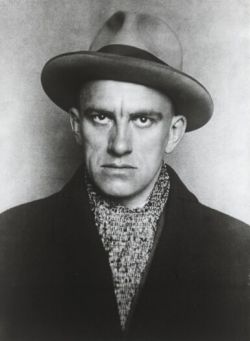Alexander Rodchenko
Alexander Mikhailovich Rodchenko (5 December 1891 – 3 December 1956) was a multifaceted Russian and Soviet artist whose contributions to painting, sculpture, graphic design, and photography helped shape the visual identity of early Soviet culture.
Early life and education
Rodchenko was born in Saint Petersburg into a working-class family. His father worked behind the scenes at a theater, and the family later relocated to Kazan where he lived with his mother. In 1910, Rodchenko enrolled at the Kazan School of Art, where he studied under instructors including Nikolai Feshin and Georgii Medvedev. During this period he met Varvara Stepanova, who would become his lifelong partner. In 1915, Rodchenko moved to Moscow to study at the Stroganov School, immersing himself in avant-garde circles alongside key figures like Vladimir Tatlin and Kasimir Malevich, and soon embraced the revolutionary ideals of the period.
Emergence of Constructivism
By 1917, Rodchenko had emerged as a key figure in the Constructivist movement. In 1921, he famously exhibited three monochrome canvases (red, yellow, blue) at the 5×5=25 show in Moscow, declaring his belief in the end of painting as an autonomous art form and prioritizing industrial design and collective functionality in art.
Work in design and photomontage
During the early 1920s, Rodchenko shifted to applied arts under the banner of Productivism, creating posters, book covers, textile designs and visual propaganda. He worked alongside poet Vladimir Mayakovsky, introducing photomontage and bold graphic layouts to Soviet advertising. One of his iconic works is the 1924 poster Books (Please) promoting literacy and knowledge dissemination.
Rodchenko later took up photography, revolutionizing it with dynamic perspective shots: shooting from high or low angles, tight cropping, and angular compositions that defied conventional visual norms. He believed that images should be captured from multiple viewpoints to create a fuller understanding of the world.
Institutional roles and teaching
In 1918–1920, Rodchenko served in the Soviet Department of Fine Arts (IZO/Narkompros), overseeing the creation of public museums and organizing provincial collections. He taught at technical art institutes, influencing a generation of artists steeped in Constructivist philosophy.
Later years and decline
By the 1930s, Rodchenko’s avant-garde methods fell out of favor under Stalinist cultural policy. Most abstract and constructivist art was condemned as formalism. He shifted to state-sanctioned photojournalism, producing photographs of parades, industry, and Soviet life. In the late 1930s he returned to painting, creating abstract works that presaged Abstract Expressionism but remained largely hidden from public view. He continued photography until about 1942 and remained creatively active until his death in 1956.
Legacy
Rodchenko’s influence extends far beyond his era. He shaped modern graphic design, shaped photographic standards, and informed movements such as Minimalism and Swiss typography. His radical rethinking of art’s purpose paved the way for functional design in mass culture and inspired countless artists in the West and East.
Selected works
- Black on Black (1918–19) – radical abstraction - Monochrome canvases (Pure Red, Pure Yellow, Pure Blue) – 1921 - Books (Please) poster – 1924 - Photographs — Stairs (1929), Fire Escape (1925), Gymnastics series (1930s)
See also
- Varvara Stepanova - Russian Constructivism - Photomontage - Productivism

